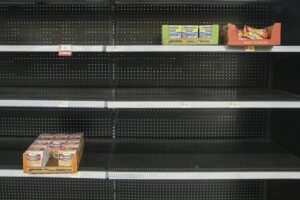 COVID-19 has revealed the limits of the supply chain practices in use today. Farmers are forced to let produce waste in the farms at a time when grocery stores shelves are empty. Until now, the common practice in B2B supply chains among retailers and manufacturers is to have fixed supply sources and items and adjust inventory in response to market changes. This practice was used to eliminate variability in demand for sellers and reduce costs and risks to buyers. The buyers leveraged stable ongoing demand for products they purchased for a better price from the sellers and thereby reduce their costs. In essence, the trading partners manage demand variability, costs and risks by limiting supply chain alternatives. But, as we saw during COVID-19, what if the sources of demand and supply are at risk? During COVID-19, consumer wants changed radically and food production capability went down with the spread of the virus. In fact, as historical data shows, markets regularly face variability not only in demand, but also in product required, supply availability and in cost of supply that supply chains have ignored only to see the breakdown amplified by the crisis. During normal times, business customers accept delays, loss of sales or incur higher supply costs with redundancy as a viable business solution given the current supply chain limitations. This limitation can be overcome with new business processes that technology solutions provide.
COVID-19 has revealed the limits of the supply chain practices in use today. Farmers are forced to let produce waste in the farms at a time when grocery stores shelves are empty. Until now, the common practice in B2B supply chains among retailers and manufacturers is to have fixed supply sources and items and adjust inventory in response to market changes. This practice was used to eliminate variability in demand for sellers and reduce costs and risks to buyers. The buyers leveraged stable ongoing demand for products they purchased for a better price from the sellers and thereby reduce their costs. In essence, the trading partners manage demand variability, costs and risks by limiting supply chain alternatives. But, as we saw during COVID-19, what if the sources of demand and supply are at risk? During COVID-19, consumer wants changed radically and food production capability went down with the spread of the virus. In fact, as historical data shows, markets regularly face variability not only in demand, but also in product required, supply availability and in cost of supply that supply chains have ignored only to see the breakdown amplified by the crisis. During normal times, business customers accept delays, loss of sales or incur higher supply costs with redundancy as a viable business solution given the current supply chain limitations. This limitation can be overcome with new business processes that technology solutions provide.
